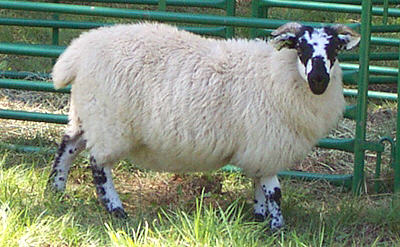Type the name of the breed you're looking for below
[wpdreams_ajaxsearchlite] Don't see the breed your're looking for? Click here and let us know!
Scottish Blackface sheep
| Place of Origin | Scotland |
| Origin | The Scottish Blackface is the most common breed of domestic sheep in the United Kingdom. This tough and adaptable breed is often found in the more exposed locations, such as the Scottish Highlands or roaming on the moors of Dartmoor. It is also known as Blackfaced Highland, Kerry, Linton, Scottish Mountain, Scottish Highland, Scotch Blackface and Scotch Horn. The origins of the breed are uncertain. It was developed on the Anglo-Scottish border but it is not clear exactly when it became a distinct breed. It replaced the earlier Scottish Dunface or Old Scottish Short-wool, a Northern European short-tailed sheep type probably similar to the modern Shetland. Records show that in 1503 James IV of Scotland established a flock of 5,000 Scottish Blackface Sheep in Ettrick Forest in the area south of Peebles in the Borders. Today the Blackface is the most numerous breed in the British Isles. Roughly thirty percent of all sheep in the UK are Scottish Blackface. The Blackface epitomises the mountain sheep. They have long coarse wool that shields them from moisture and biting winds. They are able to survive the harshest winters in the most extreme parts of Great Britain. Several types of Scottish Blackface have developed over the years, but the most common are the Perth variety, which is large framed, with a longer coat, and mainly found in north-east Scotland, Devon, Cornwall and Northern Ireland, and the medium-framed Lanark type, with shorter wool, commonly found in Scotland and Ireland. The introduction of Black Faced Highland sheep to America first occurred in June, 1861, Hugh Brodie imported one ram and two ewes for Brodie & Campbell, New York Mills, New York. In 1867 this flock and increase was purchased by T. L. Harison of Morley, St. Lawrence County, New York. Isaac Stickney of New York also imported a small flock about 1867 for his farm in Illinois. |
| Purpose | Meat, Fiber |
| Characteristics | Blackfaces are horned in both sexes, and as their name suggests, they usually have a black face (but sometimes with white markings), and black legs. This breed is primarily raised for meat. Scottish Blackface wool is a speciality wool in a class of its own. There are variations in type of fleece according to the way the sheep were bred. In general, there are a southwest type (short wool) and a central Scotland type (long wool). The southwest type is the finer, with a Bradford count of forty or so, generally classed as short or medium: ewe's fleece of 3 to 4½ lb, greasy. The central type is a stronger wool classed as long or deep strong; this type gives a ewe fleece of 5 to 6½ lb, greasy. The main markets are the mattress and upholstery trade, carpet and heavy cloth trade. Strong Blackface wool undoubtedly makes the best mattress filling there is: the demand for this is very good. The carpet trade all over the world (even New Zealand and Australia) uses large quantities of the medium class of Scottish Blackface wool. The finer wools are used for blending into many of the strong wearing clothes, over-coating,working tweeds and heavy blankets, The finest Scottish Blackface wool goes to the famous Harris tweed trade. The American Sheep Industry Association reports an average fibre diameter of 38 to 28 micrometres (or microns), and staple length of 10 to 14 inches (250 to 360 mm). Artisans have long treasured the horns of the Blackface for the carving of shepherd's crooks and walking sticks. In the US the fleeces are becoming of interest to fibre artists and hand spinners for use in tapestry and the making of rugs and saddle blankets. |
| Other Considerations | Blackface ewes are excellent mothers and will often attempt to defend their lambs against predators. They are good milkers and are able to yield a lamb crop and a wool clip even when on marginal pastures. The breed spread from the border areas during the 19th century to the highlands and the Scottish islands. They also crossed to Northern Ireland and the US. There are flocks scattered across the USA but this robust little breed has remained a minor breed in North America. Blackface lambs yield a carcass ideal for the modern consumer. The meat is free of superfluous fat and waste and is known the world over for its distinct flavour. Although they are not large sheep they have enormous potential for the production of high quality lean lamb for today's health conscious consumer. There has never been a case of natural occurring Scrapie in a Scottish Blackface Sheep. In a controlled study in the UK goats and Blackface where infected by researchers but there is not one documented case of naturally spread scrapie in a Blackface raised in the USA or the UK. Scrapie, an invariably fatal disease of sheep and goats, is a transmissible spongiform encephalopathy (TSE). The putative infectious agent is the host-encoded prion protein, PrP. |



